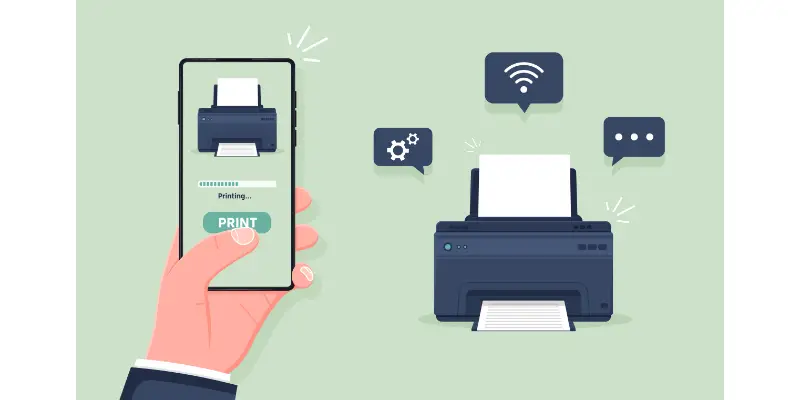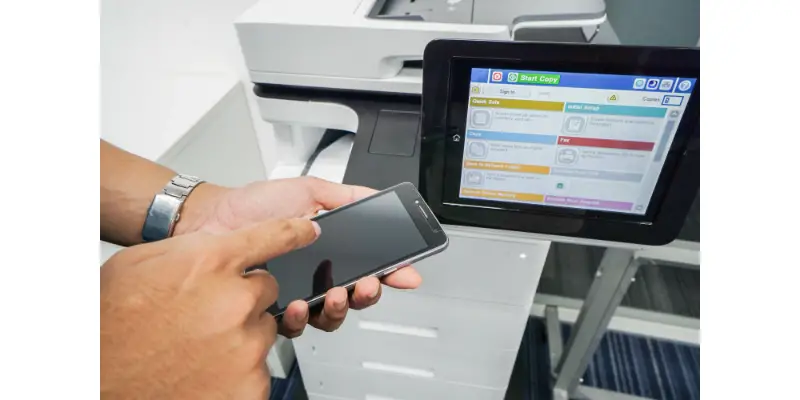Disclaimer: This post may contain affiliate links, meaning we get a small commission if you make a purchase through our links, at no cost to you. For more information, please visit our Disclaimer Page.
WiFi printing, whether at home or at work, can make a variety of printing, copying, scanning, and faxing tasks faster, easier, and more effective. WiFi printing eliminates the need for wired networking and allows for easy printing from various mobile devices. But is your WiFi printer safe?
By default, wireless printing is not safe. Any hacker with medium ability can record documents you print and recreate them into the original documents with just a medium degree of difficulty. Particularly when printing confidential documents, this may pose a risk.
In the workplace, security risks are often associated with computers or employees’ mobile phones. But your office printer poses an even greater threat.
Nowadays, printers are the most vulnerable piece of equipment, but they are often neglected in terms of security and support.
Table of Contents
How do wireless printers work?
Wireless printers connect to a wireless network and allow users to print from a variety of devices. Users can directly print from a variety of devices, including laptops, smartphones, and tablets, eliminating the need to connect them via cable and transfer files between devices.
Many people refer to wireless printers as WiFi printers because they frequently use wireless networks to receive messages.
With this new printing capability, mobile device users can print more easily and more quickly. They can send photos and documents instantly.
For example, you can take pictures with your smartphone and print them right away without having to transfer them to the computer first.
How to print from a wireless printer
There are general guidelines you can follow when setting up your printer based on the type of wireless printer you select.
Step 1: Set up a network for your printer with your WiFi connection. For computer software installation, you’ll need to temporarily link your printer to a computer using an Ethernet cable. You’ll also need to know the network’s name (SSID) as well as the password.
Step 2: To link to your preferred wireless network, use the printer’s display screen.
Step 3: Check to see if you have connected your computer to the same network. You will also need to connect your mobile device to the same WiFi network as the printer.
Step 4: When you’re ready to print, go to your device’s print menu and look for the wireless printer in the dropdown menu.
Step 5: Select the printer and then press the print button.
Many WiFi printers and WiFi all-in-one printers will come with automated set-up wizards, making wireless printing very easy.
Can a WiFi printer be hacked?
If you link your printer to the internet or your personal router and it is transmitting to the public, you are open to the possibility of someone hacking your printer due to War Driving or war chalking your wireless network.
War driving refers to a hacker riding around the neighborhood searching for vulnerable connections to something wireless. On the other hand, war chalking refers to someone roaming around searching for free WiFi or less secure networks to access.
Unscrupulous characters can use the following access points to gain unauthorized access:
- Default passwords if your printer uses its default password.
- Using your ISP’s router
- Using your personal router
- Using brute force on your wireless network or gadgets that exploit vulnerabilities in your private network
Can a wireless printer get a virus?
The cybersecurity environment is continually shifting, and new threats emerge regularly. The increase of printer malware is one of the most recent – and most interesting if you’re into that sort of thing.
One of the reasons why printer malware is becoming more prevalent is the changing ways people use printers.
Most printers, whether on your home network or in offices, are now connected via cloud services. The growth of cloud services has many benefits in terms of access, and as we store more of our personal information in the ‘cloud,’ we become more connected but also more vulnerable.
When you bind more devices to your printer, the problem worsens.
Since many businesses still don’t understand how to monitor multi-cloud environments, hackers often use printers to insert malware into a device.
Modern printers may also communicate with users via email (and sometimes other types of messaging), which demonstrates the strength of this type of attack. Malicious email attachments could bypass anti-malware software and attach your printer.
Can someone print on my WiFi printer?
In reality, printer attacks are nothing new, and it’s shocking that the concept has only recently gained traction.
Fax spam, for example, was prevalent during the fax era, when all sorts of mischief-makers were eager to spread advertisements and other materials via fax.
The majority of users are unlikely to need to connect their printers to the Internet. And since attackers can only use the method above to hack network printers, it is preferable to simply disconnect your printer from the Internet, in which case you can still access it via the local network.
It is possible and very easy to crack a network that is “protected” by a WEP password. For some years, people have been War Driving and playing with WEP-protected wireless networks and printers.
If, however, you protect your printer with a WPA and WPA2 password, hackers will have a hard time cracking your printer as it would take a large dictionary of words and a lot of time.
Only after cracking your printer’s password can one print in on your WiFi printer, but yes, it is possible. They just need to connect to your printer like you, and they will be able to print anything they wish.
How do I secure my wireless printer?
You’ll need the same protection for your printer just like you would for any other computer on the network. Here are a few steps that you should follow:
- Securing your printer (not just your server)
- Updating your printer’s operating system to fix general bugs
- Changing passwords on a regular basis
- Enabling security
- Turning off services that aren’t in use.
The following are steps you can take to ensure your WiFi printer is safe from attacks.
Make Sure All Of Your Devices Use WPA
You must use WPA or WiFi protected access on all devices involved in printing if you want to ensure that hackers cannot save copies of the documents you print. That means that:
- You must enable WPA on your router.
- You must install WPA on any device that you will be using to print.
- Your printer must use WPA.
For advice on setting up WPA, consult your wireless router’s manual. If you’re using a router less than five years old, it probably doesn’t have WPA built in so you probably need to upgrade to a better router.
Then you need to configure your home or office computers to use WPA in order for them to communicate. Regardless of whether a device runs Linux, Android, iOS, or Windows Vista or higher, as well as Mac OSX Leopard or later, it’s easy to connect to WPA routers.
These days, an increasing number of wireless printers support WPA, but you will need to check the manufacturer’s manual for details on how to set this up. You can rest easy knowing that you’re printing safely once you’ve enabled all of your devices to use WPA.
Implement password or PIN protection
Implementing password or PIN protection ensures that only authorized staff have access to the printer and its functions.
Add IDs to each individual’s account if several parties use the printer so that you can track all actions back to the source. This could discourage illegal usage and make any hacks or leaks more accountable.
Change your user PINs and passwords for the printer regularly. Never use the default settings. There is a greater risk of a security breach if a password is the same over a long period or across all devices.
Personal information such as an address, phone number, Social Security number, and other identifiers should be avoided as passwords. Also, don’t use passwords that are used too much; like numbers (1234, 4321, etc. ), your name, or the word “password”.
Instead, use a password that is a mix of upper and lower case letters, as well as special symbols.
In addition to dual two-factor authentication, some applications, such as Duo, allow users to authenticate with multiple devices. Therefore, if a printer required a personal PIN, users can authenticate with an app on their laptop.
Other Measures
Whenever necessary, print directly from the RAM rather than the internal hard drive. This ensures that the print jobs are not saved on the drive and are thus not vulnerable to attack. Similarly, if the option is available, overwrite the data stored on the hard drive immediately after printing.
Update the printer’s operating system as well. An updated printer will be safer and increases its security. Some updates also address security flaws.
Disable any programs or services that aren’t in use. This reduces the chances of someone hacking your printer because you can avoid certain applications and choices.
Close ports 9100, 515, and 721–731 on your router. To learn how to consult the user manual for your router. Check your printer settings also, and disable any settings that involve using the Internet to print.
Are WiFi printers safe?
In both professional and domestic environments, wireless printing is becoming more popular.
Like other connected technologies, wireless printers have been a target for troublemakers and hackers who want to use the networks as entry points to gain access to private information or simply cause havoc.
A wireless printer could appear to be an uncommon technology to attempt to hack remotely. What exactly does a hacker expect to accomplish? Print their papers and files on someone else’s printer – with their ink and paper?
This seems to be a small reward for a lot of work. Unfortunately, this isn’t the only way a hacker can get access to your wireless printer. An attacker could also access your previous print jobs stored on the printer’s hard drive.
All printers use an operating system to process print jobs, which will save previous print jobs until you remove and clean them. A hacker will be able to copy sensitive information from the computer’s hard drive, potentially compromising business operations.
Conclusion
Fortunately, for every professional hacker, there are teams of software and hardware developers dedicated to providing layers of protection for printers and other technologies to protect all users and their printed output.
To help secure all consumers of their devices, the top printer manufacturers hire a large number of security professionals. Thus, it is important to install the manufacturer’s security software and keep it up to date.



